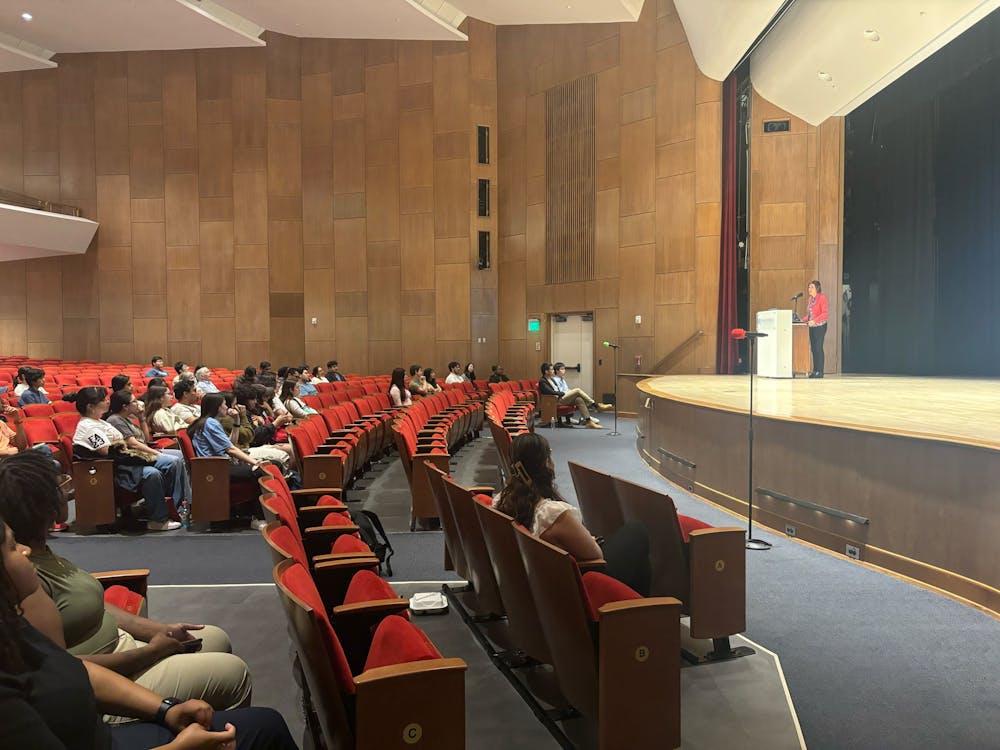On Thursday, March 14, Dr. Ellen Ochoa, the first Latina woman to go to space, was invited as the second speaker of the Spring 2024 Foreign Affair Symposium (FAS) series, Kaleidoscope: Embracing the Global Mosaic. This event was hosted by the HOP, and was sponsored by the Center for Diversity and Inclusion, the Chloe Center and the Maryland Space Grant Consortium (MDSGC).
In an interview with The News-Letter, junior Valeria Vasquez-Barros explained why this event was important for her to attend.
“I’m studying Mechanical Engineering, and I am interested in space exploration. I had watched a lot of videos about the [International Space Center] and everything — that was why I chose [to major in] Mechanical Engineering,” she said. “When I saw she was going to be here, I thought it would be cool to hear her experience, especially as inspiration.”
Over the span of her career, Ochoa has logged nearly 1,000 hours in space, served as the director of the NASA Johnson Space Center, been inducted into the U.S. Astronaut Hall of Fame and had six schools named after her. During her talk, she described the beginnings of her journey into a STEM field.
Ochoa’s grandparents immigrated to the U.S. from Mexico, and Ochoa grew up in California. The speaker emphasized her parents’ love for learning as an inspiring force in her life. Her mother, who never had the opportunity to finish high school, continued to pursue education after marriage and graduated with a degree two years after Ochoa did. Ochoa received her undergraduate degree from San Diego State University, where she majored in physics and minored in mathematics. She then went on to complete a master’s and Ph.D. program at Stanford University. Ochoa completed these ten years of schooling without paying any tuition.
Ochoa discussed the difficulties she faced when she was attempting to join Stanford’s Ph.D. program.
“A week before I took [the entrance] exam, one of my friends — another [graduate] student — had overheard one of my professors saying, ‘Well, I have never passed a woman on this test and I never plan to. I don’t think they belong in our department,’” she recalled. “Here I was thinking that as long as I was studying hard, I had a good shot of getting in. I didn’t realize there were other potential barriers.”
Despite this, Ochoa did pass the exam and was able to join the program. In the middle of her time in the Ph.D. program, Sally Ride became the first American woman to travel to space. Ride had also majored in physics as an undergraduate and studied at Stanford. A few years later, Franklin R. Chang-Díaz became the first Hispanic astronaut who made it to space. This pushed Ochoa to see a career as an astronaut as a real possibility.
“I think I really needed to see all those parallels to have it enter my mind that this was something I could do too,” she said.
After applying to be selected as an astronaut, Ochoa was initially rejected. However, NASA encouraged her to keep her application updated. In the meantime, Ochoa earned her pilot’s license. Five years later, Ochoa was finally selected. Ochoa’s first trip to space was a nine-day mission aboard the space shuttle Discovery in 1993.
Senior Diana Garza, an executive board member of the Latino student group OLÉ, shared in an interview with The News-Letter how inspiring It was to hear about Ochoa’s persistence.
“You may not know what you are interested in until you find it. And even when you do find it, you may not get it the first time. [But you] shouldn’t get discouraged,” she said.
In addition to her achievements as an astronaut, Ochoa has also been a longtime advocate for diversity and equity in STEM. She uses several mediums, including social media, podcasts and even bilingual children’s books to inspire people who have not traditionally participated in STEM careers to do so.
In an interview with The News-Letter, Ochoa described how her identity as a Latina woman has shaped her career.
“It added a whole different dimension to my career as an astronaut. I had the opportunity to do amazing things in space, but I have also been doing outreach for 30 years,” she said. “As soon as I got back from my first flight, I had many invitations to speak at schools, a lot of them with high Hispanic enrollment.”
Junior Gerardo Fontes, an organizer of the event, explained that in addition to serving as a role model for Hispanic and female students, Ochoa can serve to inspire the entire Hopkins community.
“Hopkins [is] a place that is so diverse regarding what people care about, from Political Science majors who care about geopolitics to STEM majors and engineers who care about different things,” he said. “We felt that Dr. Ochoa was someone that could bring those two things together as someone who has worked in a STEM field and managed a whole space center as well.”





